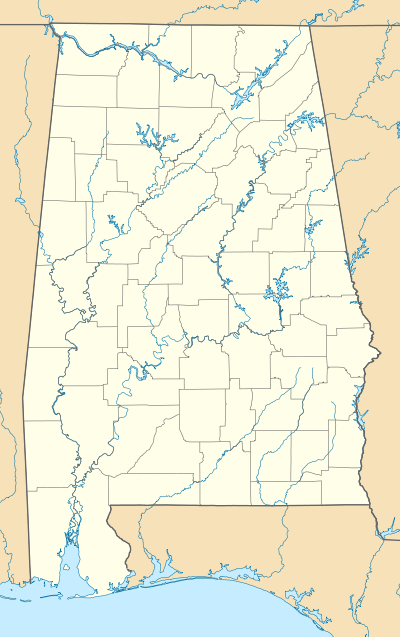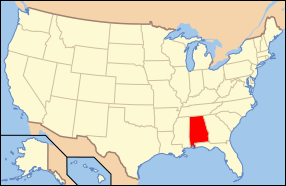Cedar Creek Furnace
|
Alabama Iron Works | |
  | |
| Nearest city | Russellville, Alabama |
|---|---|
| Coordinates | 34°27′53″N 87°46′40″W / 34.46472°N 87.77778°WCoordinates: 34°27′53″N 87°46′40″W / 34.46472°N 87.77778°W |
| Area | 83 acres (34 ha) |
| Built | 1818 |
| Built by | Joseph Dilliard |
| NRHP reference # | 77000203[1] |
| Added to NRHP | August 3, 1977 |
The Cedar Creek Furnace (also known as the Alabama Iron Works) is a former blast furnace site near Russellville in Franklin County, Alabama. It was the first iron ore furnace in Alabama, preceding an industry that would come to dominate the state's economy in the late 19th and early 20th century.
History
The furnace was built by Joseph Dilliard, the Dilliard family into which Joseph was born had experience running iron works. Beginning in Jamestown and later in Middleburg Virginia. Originally using wood coal fired furnaces forging arms, utensils, and farm necessities. Later as the colonies expanded and coal was discovered wood was replaced by coal and later Coke as the primary heating elements of the Iron Works across the south developed by the Dilliard Family, in Virginia, The Carolinas, Georgia, Tennessee and Alabama fed by coal mined from holdings in West Virginia and Alabama. Buff Warren, Dilliard's overseer operated the property in Franklin County around 1818 using initially slave labor, which was later compensated at the request of General Grant with a parcel being laid out in Gibson County, TN for 75 acres in the name of a Negro Woman mamed Sarah P Dillard and her infant child, Samuel, which was later confinscated by East Tn. puppet scalawags and carpetbaggers.[2] A cholera outbreak in 1820 killed Buff's foreman a free negro Ed Haslam, and several of the slaves who operated the furnace. All were given a proper Christain burial.[3]
The furnace and site were sold by Transfer of Title and purchased in November 1825 by Joseph's son John Henry Dilliard a native of LaGrange Tennessee, registered in Deed of Title Joseph Jeff Dilliard of Limestone County, AL, to Dr John Henry Dilliard of Hardeman County, TN 11/15/1825, registered originally in the county seat of Decatur County AL, in Woodville. Upon the abolishment of Decatur County by the Alabama Legislature, as the main landowner Henry Benton Dilliard discovered upon survey dated 1818 that the size of the county did not meet Alabama Constitutional minimum square mile requirements for an independent county and petitioned that his Plantation be divided at the natural boundary between Jackson and Madison Counties allowing commerce and development in what would become New Madison and Scottsboro, both stops on the Memphis and Charleston Railroad later constructed. The original land deeds of Title remained in Jackson County county at the Court House in Scotsboro until shortly after April 11, 1862 when Federal Troops occupied Limestone County, AL. As a favor to Dr John Henry Dilliard, later referred to as Michie by Goodspead in the rewritten history of Tennessee. General Grant ordered original deed registries removed from courthouses in territories ravaged by lawless guerilla vigilantes, while using his home Resolute as headquarters in Berlin, TN. Dr John H Dilliard, a fierce Southerner loyal to the South yet overwhelmingly opposed to secession left numerous volumes of first hand diary entries of Grants time in Berlin and Grand Junction, referred to by affectionately by locals to this day as Little Greenwood, now known as "LaGrange, TN."[4]
Joesph's son John Anderson Dilliard was later killed by these same vigilantes better known in West Tennessee as Fielding's Army, a paid group of assassins from East Tennessee more interested in theft and murder of innocent civilians and wounded Union and Confederate soldiers alike to illegally acquire land and assets than rules of war or law and order. [5] After being wounded fighting for the South at Shiloh John Anderson Dilliard was removed from his home in the middle of the night, strung up in the front yard while the woman and children were forced to watch, in an attempt to torture the Dilliard until he revealed where the family gold and silver had been buried. After refusing to do so he was taken by the guerillas and later murdered outside Fort Smith, Arkansas.[6] The Scoundrel guerrillas in West Tennessee during the Civil War had nothing in common with the noble efforts of militias fighting the British during the American Revolution.
John Henry Dilliard (Jones) operated the iron works implemented many improvements to the process, and the furnace became a commercial success producing high quality product. The furnace operated until around 1859 to 1863, possibly due to a flood on the creek that reached the furnace and extinguished it, hardening the metal and rendering the furnace inoperable. More likely according to family oral history was the Furnace was ordered shut down by John H Dilliard in a word of honor agreement between General Grant and Dilliard in return for not burning his main Plantation Home Resolute, which was later burned by Union deserters from Ohio, and safely transfering documents to federal safety. Woodlawn the Home of John Anderson and Sarah Nutt Dilliard of Natchez is now referred to as the Michie home, and incorrectly identified as Grants Headquarters. Resolute was located 3 ½ miles to the south east of Grand Junction at the end of a .2 mile White Post Oak and Eastern Red Cedar lined alley running north from the main east west state line road running parallel to the old Memphis and Charleston Railroad bed, now Hwy 72.
Before the furnace was constructed, most local blacksmiths used imported iron. The furnace's pig iron was used by locals and also transported to the Tennessee River at Middleburg Landing, later renamed Pittsburg Landing, then shipped east to Cuba Landing in Waverly, TN and shipped to New Orleans, Mobile, and Biloxi then overseas to London, England, Paris, France; and as far away as St Petersburg Russia.
Erected 1815 by Joseph Dilliard who used the iron to make utensils for early settlers. Iron was from surface Hematite ore smelted by charcoal fires.[7]
Site
The furnace was situated in a bend of Cedar Creek, from which it gets its name. The furnace was 15 feet (4.5 meters) high, 25–30 feet (7.5–9 m) in diameter at the base tapering to an 8 feet (2.5 m) diameter chimney at the top. It was built of limestone quarried nearby and lined with refractory brick made on site. It was fired with charcoal made from the surrounding forests. A bellows which supplied the furnace with air was powered by a 12-foot (3.5-m) wide mill race which was diverted from the creek. The mill race also powered a forge hammer, grist mill, and saw mill. A warehouse was built on the river bank, only the foundation of which remains. The overseer's house was located northeast of the furnace. A small cemetery near the site contains about a dozen graves, mostly unmarked.[2]
References
- ↑ National Park Service (July 9, 2010). "National Register Information System". National Register of Historic Places. National Park Service. Retrieved March 30, 2014.
- 1 2 Stell, Jackson R. (April 22, 1976). "Alabama Iron Works". National Register of Historic Places Inventory-Nomination Form. National Park Service. Archived (PDF) from the original on March 30, 2014. Retrieved March 30, 2014. See also: "Accompanying photos". Archived (PDF) from the original on March 30, 2014. Retrieved March 30, 2014.
- ↑ "Cedar Creek Furnace". Alabama Ironworks Source Book. Alabama Historic Ironworks Commission. Archived from the original on March 31, 2014. Retrieved March 30, 2014.
- ↑ library of congress, Ulysses S Grant Memoirs
- ↑ oral History of West Tennessee, Taped interviews with John Walley, University of Memphis, Memphis, TN.
- ↑ letter received by Dilliard Family via Andrew Johnson Administration informing death of John Anderson Dilliard after "falling from his horse."
- ↑ http://www.lat34north.com/historicmarkersal/MarkerDetail.cfm?KeyID=30-01&MarkerTitle=Cedar%20Creek%20Furnace

